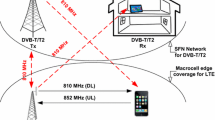Abstract
This paper investigates the possible coexistence issues between the digital video broadcasting-terrestrial (DVB-T) system and the long term evolution (LTE) that operate in adjacent frequency bands. The proposed methodology for interference assessment evaluates the DVB-T performance degradation in presence of aggregate LTE-800 interference targeting the territory of Macedonia as evaluation area. The simulation analysis quantifies the percentage of interference degraded pixels and obtains the probability of pixel DVB-T service degradation. Furthermore, a measurement trial complements the simulation analysis through the evaluation of the influence of active antenna usage by the DVB-T receivers. The simulation and measurement results in this particular case confirm that the alignment of the active DVB-T receiving antenna towards the LTE-800 base station can substantially increase the degradation whereas aligning of the active DVB-T receiving antenna towards the DVB-T transmitter maintains the efficient TV reception. Finally, this paper proposes a simple algorithm for optimal LTE frequency arrangement, resulting in significant reduction of the LTE interference towards the DVB-T system.












Similar content being viewed by others
References
Paunovska, L., Ivanoski, P., Vucikevik, D., Latkoski, P., Atanasovski, V., & Gavrilovska, L. (2013). Digital switchover (DSO) in Macedonia, background, case study and future potentials. In XI international conference ETAI, Ohrid, Macedonia.
International Telecommunications Union. (2007). Final acts WRC-07. http://www.itu.int/.
CEPT Report 30. (2009). The identification of common and minimal (least restrictive) technical conditions for 790–862 MHz for the digital dividend in the European Union.
Lazaridis, P. I., Kasampalis, S., Zaharis, Z. D., Cosmas, J., Bizopoulos, A., Latkoski, P., Gavrilovska, L., Fratu, O., & Prasad, R. (2014). UHF TV band spectrum and field-strength measurements before and after analogue switch-off. In 2014 4th international conference on wireless communications, vehicular technology, information theory and aerospace and electronic systems (VITAE), Aalborg, Denmark, 11–14 May 2014.
Guidotti, A., Guiducci, D., Barbiroli, M., Carciofi, C., Grazioso, P., & Riva, G. (2011). Coexistence and mutual interference between mobile and broadcasting systems. In Proceedings of VTC-Spring 2011 (p. 15). Yokohama, Japan.
ECC Report 148. (2010). Measurements on the performance of DVBT receivers in the presence of interference from the mobile service (especially from LTE), Marseille, France.
Coexistence of new services in the 800 MHz band with digital terrestrial television, Ofcom consultation. http://stakeholders.ofcom.org.uk/binaries/consultations/dtt/summary/dttcondoc (2011).
Second consultation on coexistence of new services in the 800 MHz band with digital terrestrial television, Ofcom consultation. http://stakeholders.ofcom.org.uk/binaries/consultations/949731/summary/condoc (2012).
The co-existence of LTE and DTT services at UHF, a field trial, Ofcom, UK. http://www.ofcom.org.uk/static/research/co-existenceLTEDTTservicesatUHF (2011).
Consultation on future use of the 700 MHz band, Ofcom consultation. http://stakeholders.ofcom.org.uk/binaries/consultations/700MHz/summary/main (2014).
Interference from LTE handsets to DTT services, Ofcom, UK. http://stakeholders.ofcom.org.uk/binaries/consultations/700MHz/annexes/ (2014).
Parker, I., & Munday, S. (2011). Assessment of LTE 800 MHz base station interference into DTT receivers, ERA technical report 2011-0351.
Parker, I. (2012). TV distribution amplifier performance when interfered with by LTE base station and subsequent mitigation filter testing. ERA technical report 2012-0112.
Pike, S. (2012). 800 MHz coexistence: practical experience from deployments and trials. In Coexistence challenges of LTE workshop. Belgium: Brussel.
Hassan, W. A., Jo, H.-S., & Rahman, T. A. (2013). Simulation model for compatibility between LTE-advanced and digital broadcasting in the digital dividend band. Smart Computing Review, 3(5), 309–322.
Denkovska, M., Latkoski, P., & Gavrilovska, L. (2014). DTT performance degradation in presence of coexisting LTE network interference. In 2014 4th international conference on wireless communications, vehicular technology, information theory and aerospace and electronic systems (VITAE), Aalborg, Denmark, 11–14 May 2014.
Agency for electronic communications in the Republic of Macedonia. http://www.aek.mk/en/.
SPLAT! RF signal propagation, loss, and terrain analysis tool for the electromagnetic spectrum between 20 MHz and 20 GHz. http://www.qsl.net/kd2bd/splat.html.
Seybold, J. (2005). Introduction to RF propagation. London: Wiley.
Shuttle Radar Topography Mission. http://www2.jpl.nasa.gov/srtm/.
Holma, H., & Toskala, A. (2010). WCDMA for UMTS: HSPA evolution and LTE. London: Wiley.
AEC Technical report. http://www.aek.mk/mk/za-nas/soopshtenija/item/download/580_9b8543e6473be57def39a28739843410.
LS Telcom. http://www.lstelcom.com.
LTE; Evolved Universal Terrestrial Radio Access (E-UTRA); Radio frequency (RF) requirements for LTE pico node B. ETSI Technical Report 136 931 (2011).
NATO SfP-984409 Optimization and Rational Use of Wireless Communication Bands (ORCA). http://orca.feit.ukim.edu.mk/ (2014).
Acknowledgments
This work is sponsored by the Public Diplomacy Division of NATO in the framework of Science for Peace through the SfP-984409 Optimization and Rational Use of Wireless Communication Bands (ORCA) project [25]. The authors would like to thank everyone involved.
Author information
Authors and Affiliations
Corresponding author
Rights and permissions
About this article
Cite this article
Denkovska, M., Latkoski, P. & Gavrilovska, L. Optimization of Spectrum Usage and Coexistence Analysis of DVB-T and LTE-800 systems. Wireless Pers Commun 87, 713–730 (2016). https://doi.org/10.1007/s11277-015-2634-5
Published:
Issue Date:
DOI: https://doi.org/10.1007/s11277-015-2634-5




